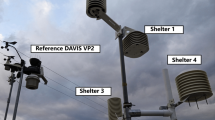Abstract
Mean radiant temperature (MRT) is an indispensable physical parameter of indoor thermal environments. Especially in indoor environments controlled by radiant systems, MRT plays an important role in thermal comfort. In order to determine MRT of indoor environments controlled by radiant cooling systems quickly and inexpensively, a numerical program is developed in this study. Based on the finite element method (FEM), view factors and radiant temperature fields are numerically calculated. The singular solution problem generated by FEM is corrected using the Monte Carlo method. The numerical program is validated against the results of an experiment performed in a radiant cooling laboratory and the reported data from previous studies. Then radiant temperature fields of different shaped surfaces in a radiant cooling indoor environment are predicted, and thermal comfort level is preliminarily evaluated.
Similar content being viewed by others
References
Yoshida A., Naka T., Chigusa N., et al., Thermal sensation and thermal load of human body in irradiated hot environment. Urban Climate, 2021, 36: 100765.
Ergonomics of the thermal environment—Instruments for measuring physical quantities. ISO Standard, 1998.
Zhou Y., Zhang T., Wang F., et al., Numerical study and optimization of a combined thermoelectric assisted indirect evaporative cooling system. Journal of Thermal science, 2020, 29(5): 1345–1354.
Xing D., Li N., Cui H., et al., Theoretical study of infrared transparent cover preventing condensation on indoor radiant cooling surfaces. Energy, 2020, 201: 117694.
Xing D., Li N., Thermal performance improvement for the ceiling radiant cooling panel with an inbuilt air gap by the convection shield. Sustainable Energy Technologies and Assessments, 2021, 44: 101012.
Xing D., Li N., Zhang C., et al., A critical review of passive condensation prevention for radiant cooling. Building and Environment, 2021, 205: 108230.
Ergonomics of the thermal environment Analytical determination and interpretation of thermal comfort using calculation of the PMV and PPD indices and local thermal comfort criteria. ISO 7730, 2005.
Van C.S., Lauriks L., Vuye C., et al., Local effects on thermal comfort: Experimental investigation of small-area radiant cooling and low-speed draft caused by improperly retrofitted construction joints. Building and Environment, 2019, 147: 188–198.
Su X., Wang Z., Xu Y., et al., Thermal comfort under asymmetric cold radiant environment at different exposure distances. Building and Environment, 2020, 178: 106961.
Zhou X., Liu Y., Luo M., et al., Thermal comfort under radiant asymmetries of floor cooling system in 2 h and 8 h exposure durations. Energy and Buildings, 2019, 188–189: 98–110.
Tian Z., Yang L., Wu X., et al., A field study of occupant thermal comfort with radiant ceiling cooling and overhead air distribution system. Energy and Buildings, 2020, 223: 109949.
Catalina T., Virgone J., Kuznik F., Evaluation of thermal comfort using combined CFD and experimentation study in a test room equipped with a cooling ceiling. Building and Environment, 2009, 44: 1740–1750.
Karacavus B., Aydin K., Numerical investigation of general and local thermal comfort of an office equipped with radiant panels. Indoor and Built Environment, 2019, 28: 806–824.
Gao S., Li Y., Wang Y., et al., A human thermal balance based evaluation of thermal comfort subject to radiant cooling system and sedentary status. Applied Thermal Engineering, 2017, 122: 461–472.
Labat M., Lorente S., Mosa M., Influence of the arrangement of multiple radiant ceiling panels on the radiant temperature field. International Journal of Thermal Sciences, 2020, 149: 106184.
https://www.theseus-fe.com/simulation-software/human-thermal-model
Yang S., Tao W., Heat transfer. fourth ed., Higher Education Press, Beijing, 2006.
Kong X., Wang D., The numerical solution of radiation angle factor of two arbitrary space curved surfaces by finite element method. Journal of Harbin Shipbuilding Engineering Institute, 1984, 1: 85–93.
Chung T.J., Kim J.Y., Radiation view factors by finite elements. Journal of Heat Transfer, 1982, 104: 792–795.
Francisco S.C., Raimundo A.M., Gaspar A.R., et al., Calculation of view factors for complex geometries using Stokes’ theorem. Journal of Building Performance Simulation, 2014, 7: 203–216.
Zheng D., Research on view factors in radiant air-conditioning rooms. Hunan University, Changsha, China, 2016.
Fontana L., Experimental study on the globe thermometer behaviour in conditions of asymmetry of the radiant temperature. Applied Thermal Engineering, 2010, 30: 732–740.
Xing D., Li N., Three-dimensional heat transfer of globe thermometers in indoor environments controlled by radiant systems. Building and Environment, 2021, 188: 107505.
Vorre M.H., Jensen R.L., Le D.J., Radiation exchange between persons and surfaces for building energy simulations. Energy and Buildings, 2015, 101: 110–121.
Zhang T, Sun B., Numerical computation of view factor of complicated configuration. Journal of Aerospace Power, 2009, 24(4): 753–759.
He F., Shi J., Zhou L., et al., Monte Carlo calculation of view factors between some complex surfaces: Rectangular plane and parallel cylinder, rectangular plane and torus, especially cold-rolled strip and W-shaped radiant tube in continuous annealing furnace. International Journal of Thermal Sciences, 2018, 134: 465–474.
Ning B., Chen Y., Jia H., Cooling load dynamics and simplified calculation method for radiant ceiling panel and dedicated outdoor air system. Energy and Buildings, 2020, 207: 109631.
Wu X., Olesen B.W., Fang L., et al., A nodal model to predict vertical temperature distribution in a room with floor heating and displacement ventilation. Building and Environment, 2013, 59: 626–634.
Zhao Q., Lian Z., Lai D., Thermal comfort models and their developments: A review. Energy and Built Environment, 2021, 2: 21–33.
Acknowledgment
This work was supported by the National Natural Science Foundation of China (No. 51878255), and China Scholarship Council (No. 202106130042).
Author information
Authors and Affiliations
Corresponding author
Rights and permissions
About this article
Cite this article
Xing, D., Li, N. Numerical Prediction of Mean Radiant Temperature in Radiant Cooling Indoor Environments. J. Therm. Sci. 31, 359–369 (2022). https://doi.org/10.1007/s11630-022-1531-y
Received:
Published:
Issue Date:
DOI: https://doi.org/10.1007/s11630-022-1531-y




